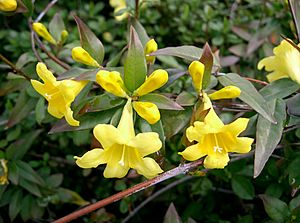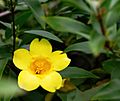Gelsemium sempervirens facts for kids
Quick facts for kids Gelsemium sempervirens |
|
|---|---|
 |
|
| Scientific classification | |
| Genus: |
Gelsemium
|
| Species: |
sempervirens
|
| Synonyms | |
|
|
Gelsemium sempervirens is a climbing plant, also known as yellow jessamine or Carolina jasmine. It's a type of vine that belongs to the Gelsemiaceae family. You can find it growing naturally in warm, sunny places like Honduras, Guatemala, Belize, Mexico, and the southeastern United States, from Texas all the way to Virginia. This beautiful plant is even the official state flower of South Carolina!
Contents
How It Grows
This plant loves to climb! Gelsemium sempervirens can grow quite tall, reaching about 3 to 6 meters (10 to 20 feet) high if it has something to climb on, like a tree. Its stems are thin, and its leaves stay green all year round. The leaves are shiny and dark green, shaped like a spear, and are about 5 to 10 centimeters (2 to 4 inches) long.
The flowers grow in groups and are bright yellow, sometimes with an orange center. They are shaped like a trumpet, about 3 centimeters (1.2 inches) long. These flowers have a very strong, sweet smell. They also make a sweet liquid called nectar, which attracts many different insects that help pollinate the plant.
Is It Safe? (Toxicity)
It's very important to know that all parts of the yellow jessamine plant are poisonous if eaten. They contain natural chemicals that can be harmful. The liquid inside the plant's stems and leaves, called sap, might also make some people's skin itchy.
Sometimes, children might mistake these pretty yellow flowers for honeysuckle and try to suck the nectar. This is very dangerous because the nectar is also poisonous. Even honeybees can be harmed if they collect too much nectar from this plant. It can even cause problems for their young.
However, some studies show that the nectar might actually help bumblebees. When bumblebees eat a little bit of the plant's chemicals, it might help them fight off tiny parasites. This suggests that some animals might use these plant chemicals like medicine! Still, for humans and many animals, this plant is dangerous and should not be eaten. It can even be deadly for farm animals like livestock.
Growing Yellow Jessamine (Cultivation)
Even though it's poisonous, yellow jessamine is a very popular plant for gardens in warmer areas. People often train it to grow over arches or to cover walls, making a beautiful display. In the United Kingdom, it has even won a special award for being a great garden plant!
If you live in a mild area, you can grow it outside. But in colder places, it needs to be grown in a greenhouse to protect it from freezing temperatures. It likes a sunny spot or a place with a little bit of shade.
Gallery
-
Cloudless Sulfur Caterpillar (Phoebis sennae)
See also
 In Spanish: Gelsemio para niños
In Spanish: Gelsemio para niños




